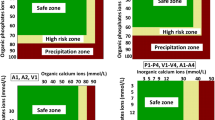Abstract
Aluminum (Al) contamination of parenteral nutrition (PN) solutions has been known for over 30 years. In particular, vascular intake of Al leads to its accumulation in tissues. In this study, 8 all-in-one PN solutions the aluminum concentration was analyzed by high-performance liquid chromatography. The mean Al concentration of the glucose solutions of the PN solutions combinations was 16.36 ± 8.31 µg/L, the mean Al concentration of the amino acid solutions was 4.96 ± 3.73 µg/L, and the mean Al concentration of the lipid solutions was 9.09 ± 11.23 µg/L. The Al concentration of the PN5 glucose and PN2 lipid solutions were above 25 µg/L, which is the limit set by the Food and Drug Administration (FDA). No studies in the literature have examined the Al concentrations of all-in-one PN solutions via HPLC. In two of the analyzed solutions, the Al concentration was found to be higher than the limit set by the FDA.
This is a preview of subscription content, access via your institution
Access options
Subscribe to this journal
Receive 12 print issues and online access
$259.00 per year
only $21.58 per issue
Buy this article
- Purchase on Springer Link
- Instant access to full article PDF
Prices may be subject to local taxes which are calculated during checkout

Similar content being viewed by others
References
Klein GL. Aluminum in parenteral solutions revisited-again. Am J Clin Nutr. 1995;61:449–56.
Klein GL, Alfrey AC, Miller NL, Sherrard DJ, Hazlet TK, Ament ME, et al. Aluminum loading during total parenteral-nutrition. Am J Clin Nutr. 1982;35:1425–9.
Working Group on Standards for Aluminum Content of Parenteral Nutrition Solutions. Parenteral drug products containing aluminum as an ingredient or a contaminant: response to Food and Drug Administration notice of intent and request for information. ASCN/A.S.P.E.N. JPEN J Parenter Enter Nutr. 1991;15:194–8.
Charney PJ, American Society for P, Enteral Nutrition Aluminum Task F. A.s.p.e.N. Statement on aluminum in parenteral nutrition solutions. Nutr Clin Pract. 2004;19:416–7.
Hernandez-Sanchez A, Tejada-Gonzalez P, Arteta-Jimenez M. Aluminium in parenteral nutrition: a systematic review. Eur J Clin Nutr. 2013;67:230–8.
Food and Drug Administration, HHS. Aluminum in large and small volume parenterals used in total parenteral nutrition. Food and Drug Administration Fed Regist. 2000;65:4103–11.
Bohrer D, do Nascimento PC, Binotto R, Becker E. Influence of the glass packing on the contamination of pharmaceutical products by aluminium. Part III: interaction container-chemicals during the heating for sterilisation. J Trace Elem Med Biol. 2003;17:107–15.
de Oliveira SR, Bohrer D, Garcia SC, do Nascimento PC, Noremberg S. Aluminum content in intravenous solutions for administration to neonates: role of product preparation and administration methods. JPEN J Parenter Enter Nutr. 2010;34:322–8.
Poole RL, Schiff L, Hintz SR, Wong A, Mackenzie N, Kerner JA Jr. Aluminum content of parenteral nutrition in neonates: measured versus calculated levels. J Pediatr Gastroenterol Nutr. 2010;50:208–11.
Shibukawa M, Koyahara K, Mishina A, Saitoh K, Nishigaki A. Determination of trace amounts of aluminum in environmental and biological fluids by reversed-phase ion-pair liquid chromatography with fluorometric detection using 5-sulfoquinoline-8-ol. Curr Chromatogr. 2016;03:123.
Author information
Authors and Affiliations
Corresponding author
Ethics declarations
Conflict of interest
The authors declare that they have no conflict of interest.
Additional information
Publisher’s note Springer Nature remains neutral with regard to jurisdictional claims in published maps and institutional affiliations.
Rights and permissions
About this article
Cite this article
Öztürk, E., Yıldırım, S. & Akyol, A. Determination of aluminum concentrations of parenteral nutrition solutions by HPLC. Eur J Clin Nutr 75, 567–569 (2021). https://doi.org/10.1038/s41430-020-00741-0
Received:
Revised:
Accepted:
Published:
Issue Date:
DOI: https://doi.org/10.1038/s41430-020-00741-0
This article is cited by
-
Determination of aluminium concentrations in black, green, and white tea samples: effects of different infusion times and teapot species on aluminium release
European Food Research and Technology (2024)
-
Electroanalytical determination of Al(III) ion in petroleum water samples using symmetric 1,3-diamine-based Schiff base as a carrier
Journal of the Iranian Chemical Society (2022)



